Have you ever noticed guests wrinkling their noses when entering your home? Do friends politely decline your dinner party invitations, explaining that they’re allergic to dogs?
These are familiar problems for many dog owners. Fortunately, there’s something you can do about that: Invest in a good air-purifier.
Good air purifiers will help neutralize the odors your dog creates and clear the air of dander too. For that matter, air purifiers help ensure your four-footer gets to breathe cleaner air, which will provide many of the same benefits you enjoy when breathing clean air.
But – and this is a big but – it is imperative that you select an air purifier that is safe for dogs. Many produce harmful byproducts, which can cause significant health issues for your pets.
Worry not, fellow dog lover! We are here to help.
Below, we’ll explain everything you need to know about air purifiers, including the best way to pick one that’ll be safe for your pet. We’ll even identify a few of the best ones on the market, to make the process as easy as possible.
There’s a lot we need to explain about air purifiers before getting to our product recommendations, but you can check out our quick picks if you’re in a hurry!
Best Air Purifiers For Dogs: Quick Picks
- #1 Hamilton Beach TrueAir Pet & Odor Eliminator [Best Air Purifier for Small Spaces] — Just need to clean up the air in your small apartment or basement? The TrueAir Pet & Odor Eliminator is an easy winner.
- #2 NuWave OxyPure Smart Air Purifier [Best Premium Air Purifier] — Want ultra-clean air and don’t mind paying for it? The NuWave OxyPure is a no-brainer.
- #3 KOIOS Air Purifier [Best Budget Pick] — If you want a high-quality air purifier that won’t break the bank, the KOIOS Air Purifier is a great choice.
The Benefits of Air Purifiers: Good for People; Good for Pets
One of the first things dog owners should know is that air purifiers are often beneficial for you and your pet.
Once you set your home up with a safe and effective purifier, you’ll find that dog smells in your house start to disappear (as well as the odors wafting out of your trashcans, bathroom, and teenager’s bedroom).
Additionally, a good air purifier will remove particulate matter from the air. This not only includes pet dander, but also dust, smoke, and potential health hazards like mold spores and bacteria.
By eliminating odors and particulate matter, you’ll be able to enjoy cleaner, fresher, better-smelling air throughout your home.
But a good air purifier will also help your pet breathe easier too. Dogs can also suffer from things like nasal congestion and environmental allergies, so your pet will also appreciate the services an air purifier provides.
Finally, air purifiers simply help many people feel better about their health and that of their families (including two- and four-footed members). Air purifiers obviously won’t guarantee you’ll remain in good health, but they sure are a step in the right direction.
To recap, air purifiers may:
- Reduce allergy symptoms for people
- Reduce allergy symptoms for pets
- Remove hazardous substances from the air, helping keep pets and people healthy
- Eliminate odors
- Provide some peace of mind for you and your family

Different Types of Air Purifiers: Which Ones Are Safe for People and Pets?
Air purifiers come in several different styles, each of which uses a different technology (or combination of technologies) to get the job done.
But, as we mentioned earlier, some air purifiers are dangerous for pets – they may even be dangerous for people too. So, it is important to familiarize yourself with the different types of air purifiers on the market and select the safest one for your home.
It’s also helpful to understand that different types of air-purifying technology address different types of pollutants.
Some are great at eliminating odors, while others are good at pulling particulate matter from the air. And some of the very best ones are pretty good at doing both.
We’ll break down the six basic types of air purification technology below.
UV Filters
UV filter technology is pretty straightforward: Air is drawn into a chamber of some type and blasted with UV light (which kills many organisms). The air is then blown back out into your home, ostensibly free of infectious pathogens.

Hospitals and some industrial processes utilize UV light to sterilize objects, and the technology is really pretty well-established. However, there are a few issues with air purifiers that utilize UV technology.
First of all, UV light won’t do much to make the air smell better. Odorous molecules will still remain in the air after being exposed to UV light. UV technology also works somewhat poorly on dirty, particle-laden air; the particles “shield” the germs in the air from the UV rays.
This is part of the reason many air purifiers that utilize UV technology first clean the air with a mechanical filter of some type.
But perhaps the most troubling thing about UV air purifiers is that it isn’t clear how effective they are in most air purifiers. For UV light to kill pathogens, it needs to blast them for a substantial amount of time.
The specific amount of time required varies based on a billion things, but it appears that many consumer-level air purifiers fail to keep the air being treated exposed to UV rays for long enough to work.
That aside, there’s not really any reason to avoid air purifiers that use UV light, as it’s pretty safe. The light itself is dangerous, so don’t go opening up the unit and futzing around with stuff, but it doesn’t create any harmful byproducts.
Mechanical Filters

Mechanical filters are perhaps the simplest and most intuitive type of air-purifying technology on the market — they are essentially fancy screens with crazy small holes.
The dirty air from your home is collected and forced through the screen, which traps particulate matter while allowing clean air to pass through. The cleaned air is then pumped back out into your home.
The crux of the issue with mechanical filters is the size of the holes in the screen. Essentially, you want a purifier that uses a filter with very small holes – if the holes are too large, pollutants can slip right through.
The gold-standard mechanical filters are called high-efficiency particulate air filters. You’ve heard of these before; they’re called HEPA filters. HEPA filters remove at least 99.97 percent of the particulates that are 0.3 microns in size or larger. Bacteria range in size from about 0.2 microns to 1.0 microns wide, so HEPA filters will collect many of the ones floating in the air.
Unfortunately, viruses are an order of magnitude smaller, so they’ll flow right through HEPA filters. Similarly, odors – which are often caused by even smaller particles than viruses – will also pass right through a HEPA filter.
Mechanical filtration (including HEPA technology) is pretty darn safe for you and your doggo. You want to be careful when cleaning these filters, lest you send the collected cooties back into the air, but they don’t release any toxic gases or other hazards.
Activated Carbon Filters
Activated carbon filters (sometimes called charcoal filters) are a pretty common type of air purifier technology, and they’re used in things ranging from water purifiers to aquarium filters. These also work in an easy-to-understand fashion.
Carbon atoms are incredibly good at bonding in scads of different ways with myriad molecules and atoms. Carbon atoms are just sitting there waiting to latch on to something – and this includes odorous molecules, like sulfur-based compounds.
So, you pass some air with sulfur-based stinkiness through a big hunk of carbon, and most of the sulfur will bond with the carbon. This means you’ll have much less sulfur (or whatever other molecules are creating the odor) in the air, which will make the air in your home smell better.
The “activated” part of the name just refers to the fact that the carbon is pressed in a way that gives it tons of tiny holes, which increase the surface area available and make it more effective.
Carbon filtration technology won’t remove many particulates from the air, so don’t expect it to help with your dog or mold allergies. This is part of the reason activated carbon filters are often only a single step in the air-filtering process used by high-quality models.

But carbon filtration is safe and won’t yield any harmful byproducts, so you can use the technology without worry.
But there are also a few issues with activated carbon filters. For one, they must be cleaned regularly – you have to get rid of those smelly molecules that have bonded with the carbon.
Additionally, it takes a substantial amount of carbon to effectively clean the air; you essentially need a multi-pound hunk of carbon to get the job done. And few air purifiers (if any, on the consumer level) have such large carbon filters.
Note that carbon filtration technology sounds like a type of mechanical filtration, but it’s better thought of as chemical filtration. It is the chemical nature of the carbon that creates the air-cleaning magic, rather than its net-like structure.
Ozone-Producing Purifiers
For reasons you’ll soon understand, ozone-producing purifiers have largely fallen out of favor. We recommend our readers avoid ozone purifiers entirely. But it’s important to understand why this is the case.
You’ve probably heard of ozone before. It is a significant part of the earth’s upper atmosphere, and it helps to protect us from some of the sun’s most harmful rays. Without it, life on earth would be much different – if it existed at all.
But that doesn’t mean ozone is harmless, because it’s not. In fact, ozone can cause a variety of respiratory-related health problems for humans (and other animals) who breathe it.
Ozone is a simple chemical, consisting of three oxygen molecules (O3) bonded together; by contrast, atmospheric oxygen – the kind we breathe — is comprised of only two oxygen molecules (O2).
That third oxygen atom doesn’t really “want” to stay attached to the others, so when an ozone molecule bumps up against some other types of molecules (including many that smell bad), it often “donates” that third oxygen atom to the other chemical.
This chemical change in the odor-causing molecule effectively changes its properties, thereby eliminating the odor and resulting in fresher-smelling air. This won’t, however, have much of an effect on particulates in the air, so they’re pretty useless for dealing with allergies.
The regulatory environment surrounding air purifiers – especially those that produce ozone – is complicated, and it relates to how the purifier is marketed.
Suffice to say, many ozone-producing purifiers create higher ozone concentrations than are thought to be safe for people, and many pets are even more susceptible to the problems the compound can cause.
Simply put, you’ll want to avoid ozone-producing purifiers.
Ionizing Purifiers
Ionizing purifiers work by creating and releasing a large number of particles called ions – atoms or molecules that have a net positive or negative charge. When you start pumping these ions into the air in your home, they bond with oppositely charged (and often smelly) particles.
Once this happens, the resulting compounds become too heavy to float in the air. No more smelly particles in the air means no more odor in your home.

So, while ionizing purifiers won’t remove the dander or dust from the air in your home, they will often make your home smell much better.
They may, however, help reduce the amount of very small particles floating in the air, such as smoke particles in the same basic way – they bond with the smoke particle, thereby making it too heavy to float.
But there are significant downsides to these types of purifiers, which is why we do not recommend them.
The biggest issue with ionizing purifiers is that they may produce ozone, which is – as previously mentioned — a hazardous gas (in significant quantities). Ozone can irritate the lungs of you and your dog, and it can even kill small pets with high respiratory rates, such as birds.
Additionally, the bonded compounds ion-generating purifiers create will often stick to your walls and floors.
Photocatalytic Oxidation Purifiers
As with ozone-producing and ionizing purifiers, photocatalytic oxidation purifiers are best avoided – whether you have a pet or not. To understand why, you’ll need to learn a bit about the technology.
Photocatalytic oxidation purifiers are perhaps the most complicated air-purifiers available, and they can be a bit tricky to understand.
At a basic level, these purifiers use UV light and chemicals like titanium dioxide to produce compounds that are capable of oxidizing gaseous pollutants. Once oxidized, the compounds will typically not cause any more foul odors.
On the upside, photocatalytic oxidation purifiers are effective at dealing with particles measuring 0.001 microns in size or larger. This is obviously pretty impressive, but it isn’t yet clear how effective these types of purifiers work in practice. On the downside (and it’s a pretty big downside), they can be dangerous.
Specifically, photocatalytic oxidation purifiers create harmful gases, including ozone and formaldehyde. For this simple reason, you’ll want to avoid any air purifiers using this type of technology.
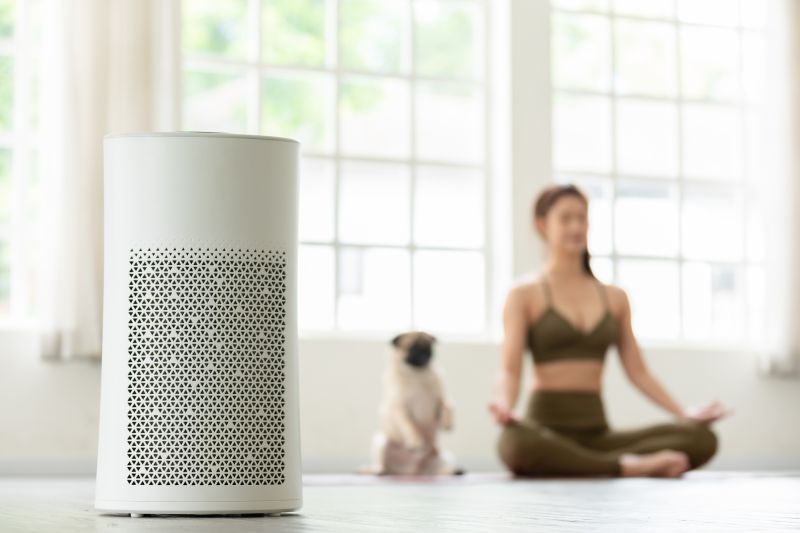
Multiple Filtration Technologies for the Win!
As we mentioned, some purifiers utilize more than one of these technologies at the same time. This is a great strategy, as it allows some types of air-cleaning technology to address problems another technology fails to address.
For example, many high-quality air purifiers will utilize a HEPA filter, an activated carbon filter, and a UV filtration module. This means they’re cleaning the air in three different ways, and they’re dealing with different types of pollutants, including smelly gases, dander, and some bacteria or molds.
But, there are also air purifiers that use one of the dangerous processes – such as ozone-producing technology – to treat the air in your home. These should be avoided, as there’s nothing about activated carbon (for example) that’ll make these types of units safe.

The Five Best Air-Purifiers for Pet Owners
Whew. There’s a lot to learn for pet owners in search of an air purifier. But now that we’ve explained all the basics, we can point you to a few of our favorite models on the market.
Check ‘em out below, and just be sure that you consider your specific needs when making your choice.
1. Hamilton Beach TrueAir Pet & Odor Eliminator
This is a sponsored placement, in which an advertiser pays a fee to be featured in this article. Learn more
About: There are a few air purifiers available that are marketed specifically for pet owners, but the Hamilton Beach TrueAir Purifier is easily among the best options.
It features three different filtration stages, including two carbon-based filters and a HEPA filter. Best of all, you don’t have to worry about replacing the HEPA filter – you can just vacuum it to remove the debris it collects.
This purifier operates at your choice of three fan speeds, and you can set it up vertically or horizontally to make the most of the space you have available.
It is rated for cleaning rooms with up to 140 square feet of space, and it has an ultra-quiet mode that is helpful for light sleepers who don’t want to be disturbed at night.
Features:
- Three filtration stages; two replaceable carbon filters and one reusable HEPA filter
- Eliminates mold or mildew spores as small as 3 microns in size
- Permanent pre-filter specifically designed to remove pet hair
- Carbon filters should be replaced four times per year
PROS
The majority of the owner reviews were glowing, and this included many pet owners. Several specifically mentioned that the purifier eliminated pet hair and tough-to-treat odors, including cat and dog urine. A few users even explained that they set up the unit right next to their dog’s crate, which helped keep their home smelling fresh and clean.
CONS
Generally speaking, negative reviews were rare for this air purifier, and many seemed to be the result of users who didn’t understand what they were getting. For example, some were disappointed that the HEPA filter wasn’t “washable” (you need to vacuum it instead). Additionally, a few complained that it was loud.
2. Honeywell HPA300
This is a sponsored placement, in which an advertiser pays a fee to be featured in this article. Learn more
About: There are tons of air purifiers on the market that’ll help clean the air in small rooms, but there are fewer options for those that need to clean really big rooms. Fortunately, the Honeywell HPA300 is capable of helping you and your pet breathe easier in rooms up to 465 square feet. In fact, it’ll treat the entire volume of air in such rooms five times per hour.
The number one choice of allergists (according to Honeywell), the HPA300 features a pre-filter to remove large particles and a HEPA filter to remove smaller stuff. Third-party testing has demonstrated that this unit even eliminates many bacteria, mold spores, and viruses (though it isn’t entirely clear how it accomplishes this feat).
Features:
- Control panel dimmer to make it easy to use at night
- Filter change indicator means you will know when filters need replacement
- Automatic turn-off function
- Backed by the manufacturer’s 5-year warranty
PROS
Most of those who shared their thoughts about this purifier raved about it. A few people mentioned that it had improved their breathing problems so much that they no longer had to take allergy medications, with at least one describing it as a “miracle machine.” A few customers even tried three or more purifiers head-to-head and ended up picking the HPA300. Finally, while not cheap, this unit seems to provide great value for your air-purifying dollar.
CONS
As is common with a number of air purifiers, a handful of folks complained about a “plastic” or “chemical” odor. Customer service also earned some complaints, but that’s to be expected from disappointed consumers, and just about every product in the world suffers from similar criticisms at times.
3. KOIOS Air Purifier
This is a sponsored placement, in which an advertiser pays a fee to be featured in this article. Learn more
About: We get it – money is tight, but you’d prefer if your apartment smelled a little less “doggy.” Or maybe your roommate is allergic to dogs and you need to cut down on the dander in the name of household harmony. Well, the KOIOS Air Purifier is likely exactly what you need.
Not is the KOIOS Purifier affordable, it is safe and effective too. It produces no ozone, it provides 360-degrees of air-cleaning action, and it will clean 55 cubic meters of air per hour. It also utilizes three different filtration technologies: a fine mesh prefilter designed to catch and collect large dust particles, a HEPA filter to catch most things that are left, and an activated carbon filter to neutralize foul odors.
Features:
- 100% Ozone Free Certified by Carb
- Turn the unit on or off, change fan speed, & control nightlight with one button.
- Noise-reducing fan blade design keeps the unit quiet
- Backed by a 30-day, no-hassle refund policy and 3 years of 24/7 customer support
PROS
It’s not often we encounter a product that is so affordable and enjoys so many positive user reviews. It appears to work fabulously for relatively small spaces, and it deals with everything from smoke to pollen to dander with ease. Many reports also praised the unit’s aesthetics and quiet operation too.
CONS
Complaints about the KOIOS Air Purifier were pretty rare, and the reasons for them varied. A few owners felt the unit’s light was annoying, and a few felt that it lacked the umph to handle large rooms. A few buyers also reported problems getting customer service on the phone. But, the scattershot nature of these complaints suggests these are one-off problems that most buyers won’t experience.
4. NuWave OxyPure Smart Air Purifier
This is a sponsored placement, in which an advertiser pays a fee to be featured in this article. Learn more
About: Looking for one of the best air purifiers on the market and not afraid to pay for it? The NuWave OxyPure Air Purifier definitely deserves your attention. Designed to treat up to 1,000 square feet, this top-of-the-line air purifier utilizes five(!) different filtration steps, including one that kills bacteria and mold. Further, this unit not only avoids producing ozone and ions, but it also filters out ozone already in the air of your home!
This unit includes a ton of other bells and whistles as well. You can control it with your smartphone or laptop, it has an eco-friendly mode that automatically adjusts the operation to keep the air clean while saving energy, and it features the Energy Star logo.
Features:
- Five separate filters, including three with 20-year lifespans
- Bioguard filter actually eliminates bacteria, rather than simply trapping them
- 360-degree intake for maximum efficiency
- Air-quality sensor adjusts the unit’s operating speed as necessary
PROS
There’s no question about it, this is a premium-quality air purifier and it should work extremely well for pet owners. User reviews were overwhelmingly positive and included phrases like “WOW,” “worth every dime,” and “the best I ever bought.” Additionally, several owners praised its ease of operation and reported that it was a “plug and play” device.
CONS
*Whistles* This thing is expensive – there’s no getting around it. Aside from that, most complaints related to one-off shipping or packaging issues, and a few users had issues with its Wifi functionality and the associated app.
5. LEVOIT H13
This is a sponsored placement, in which an advertiser pays a fee to be featured in this article. Learn more
About: One of the most common complaints about air purifiers is that the noise and light they create can make it difficult to sleep. But the LEVOIT H13 makes those problems a thing of the past, as it is not only quiet but features an adjustable light too – you can choose between two different brightness levels or turn the light off completely.
Even though it’s equipped with three different kinds of filter – a mechanical pre-filter, a HEPA filter, and a carbon filter – this air purifier is pretty compact, making it easy to fit into your home. It also features a nifty “change filter” indicator, so that you’ll know when you need to swap out the filters.
Features:
- Will process the air in a 129-square-foot room four times per hour
- Can be successfully used to clean the air in rooms up to 516 square feet
- Backed by a 2-year warranty
- CARB Certified, FCC certified, and ETL listed
PROS
As with all of the other air purifiers discussed here, the LEVOIT H13 received glowing reviews from users. Most people who tried it loved it, with several characterizing it as the best purifier they’ve ever owned. This includes several people who purchased it specifically to deal with pet odors. The adjustable light and quiet operation also received plenty of praise.
CONS
A few people that purchased this unit complained that this unit didn’t seem to be powerful enough to clean the air in a room of the rated size. Most other complaints related to one-off manufacturing problems, such as a fan that rattled.
Picking an Air Purifier: Things to Think About
It can be a bit overwhelming to look at all the purifiers available, but we’ll try to help you narrow things down. Below, we’ll talk about some of the key features and characteristics you’ll want to consider before plopping down your credit card.
The Type of Air-Purifier
The first thing you’ll want to think about is the type of air purifier you want.
In other words, do you want a purifier that uses a HEPA filter to clean the air, or do you think an activated carbon filter will work better for your needs? Do you want a purifier that utilizes UV-light to kill germs, or do you think that’s unnecessary? And, of course, you could select a purifier that utilizes all three of these technologies.
Ultimately, you can pick any or all of these three technologies without worry, but you’ll want to avoid those that produce ions or ozone, as well as those that use photocatalytic oxidation technology.
Clean Air Delivery Rate (CADR)
The CADR is a measure of how much clean air a purifier produces when operating at its highest speed. This rating usually applies to a specific pollutant, such as smoke.
As a rule of thumb, consider any unit with a CADR of 120 or above as good, and any unit with a CADR of 240 or more as excellent.
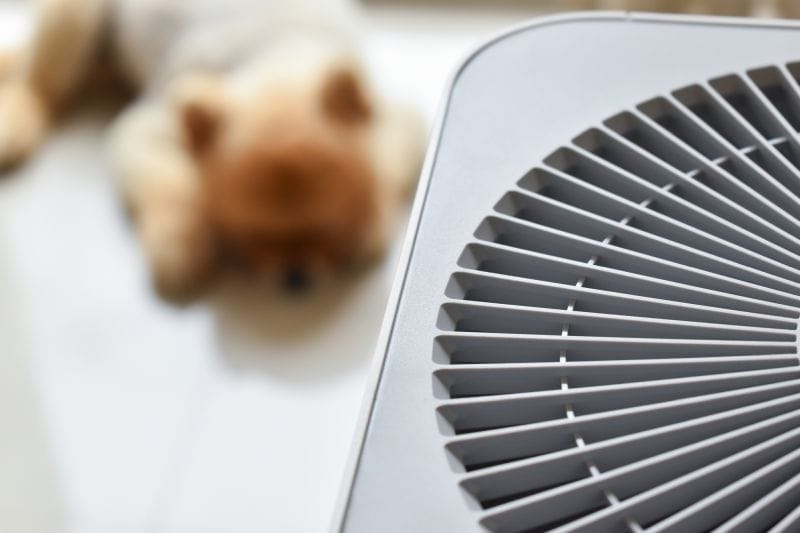
Space Rating
Air purifiers are designed to clean different amounts of air. You can’t reasonably expect a tiny air purifier intended for bathroom use to keep an airplane hanger smelling good. It just won’t be up to the job.
So, be sure to consider the space you’re trying to treat when picking a purifier. You’ll need a much higher-powered purifier to treat your entire house than you would to keep your bedroom’s air clean.
There’s nothing wrong with picking a purifier that’s rated for a much larger room than you need – at least in terms of safety or the function of the purifier. But this may cause you to spend more money than necessary, and it may inflate your power bill more than you’d like too.
Space ratings may be provided in terms of square footage (or square meterage, for our friends outside the US) or cubic footage. To find the cubic footage of your room or house, simply multiply the square footage by the height of the room.
Physical Size
It is often important to consider the physical size of an air purifier – you don’t want to be forced to look at a gigantic contraption messing up the aesthetics of your living room if you don’t need to. And in some cases, you may find that you simply don’t have room to accommodate a super-sized unit.
Just consider where you’re going to set up the purifier and get a ballpark idea of the space you have available when making your choice.

Noise Level
One thing that many people fail to consider is the noise air purifiers – particularly the unit’s fan — may make. Simply put, some purifiers are loud.
This isn’t a problem for all pet owners; some want all the peace and quiet they can get, but others won’t even notice the sound a purifier creates over the cacophony of noise emanating from kids, pets, TVs, and other household devices.
Once again, it is also important to consider the place you’ll be using the purifier. If you want to keep it in your bedroom, you’ll probably want to pick a very quiet one. Also, keep in mind your pet’s attitude to the noise, especially if you’ll be setting it up in an area your four-footer frequents.
At the end of the day, you just want to select a very quiet unit if you think noise may be an issue.
If you don’t care about noise, save some money or enjoy the benefits and features louder units may provide.
On-Going Maintenance
Over time, most air purifiers will require some type of maintenance to continue operating efficiently. The nature of this maintenance will vary, but – for those that rely on some type of filter – it essentially means you’ll need to clean or replace the filter from time to time.
There’s no great way to get around this, so just try to consider how frequently the manufacturer predicts you’ll need to clean the filter. Note that some air purifier manufacturers claim their filters do not need cleaning, but such claims almost invariably turn out to be false.
In fact, if you want a purifier that utilizes any type of mechanical filtration, you should avoid models that don’t provide easy access to the filter media. Otherwise, you’ll simply find it necessary to replace the entire unit at some point.
Cost
It’s all about the Benjamins, baby.
Money is a finite resource, and dollars you spend on an air purifier are dollars you can’t spend on treats, toys, and trainers for your doggo.
So, be careful that you don’t buy a more expensive unit than you actually need. A caviar-caliber air purifier won’t cause you any problems, but it may not produce any tangible benefits over a mid-range model for your 2-bedroom apartment.
But that doesn’t mean you should always opt for the cheapest model, either.
Sure, a bargain-priced air purifier may help clean the air in your home for a month or two, but it’ll likely break in short order. Plus, if may not clean the air as effectively as you’d want.
Bottom line: Consider your budget and needs, then shop accordingly.
Energy Star Logo

Speaking of cost, make sure that you realize it will cost you money to operate your new purifier.
This not only includes replacement filter cartridges (if applicable), but also the electricity the unit requires. After all, your purifier will work best and your air will stay the cleanest if you keep it running constantly. Over time, this will add up to real dollars and cents.
One great way to minimize this type of power-bill impact is to pick a purifier that features the Energy Star Logo. We’re not going to do a deep dive into the logo and what it means, except to say that appliances bearing it have been determined by the U.S. Environmental Protection Agency and/or the U.S. Department of Energy to operate at a given (or relative) efficiency level.
Simply put, products with the Energy Star Logo will generally save you a bit of cash over the long-term. They’ll also help you do your part to help combat climate change.
We’re not saying you should base your whole decision-making process on the logo. But, if you’re faced with two similar units, pick the one with the cute little star emblem.
Misleading Language
Unfortunately, as occurs in many industries and product categories, manufacturers and retailers occasionally use misleading – or downright false – language to help sell more stuff. In the air-purifier category, this most commonly occurs among those selling ozone-producing purifiers.
Because most consumers now avoid purifiers that produce ozone, companies have begun using creative language to fool the public or side-step regulations.
So, instead of just stating that a purifier produces ozone, they’ll say that it produces “super oxygen,” “activated oxygen,” or “energized oxygen.” These terms just refer to the fact that ozone contains three atoms of oxygen, rather than the two atoms atmospheric oxygen does.
Not only should you avoid purifiers named this way to protect your family and four-footers from ozone, but you also have to wonder how honest and forthright manufacturers and retailers offering such products have been with their other claims.
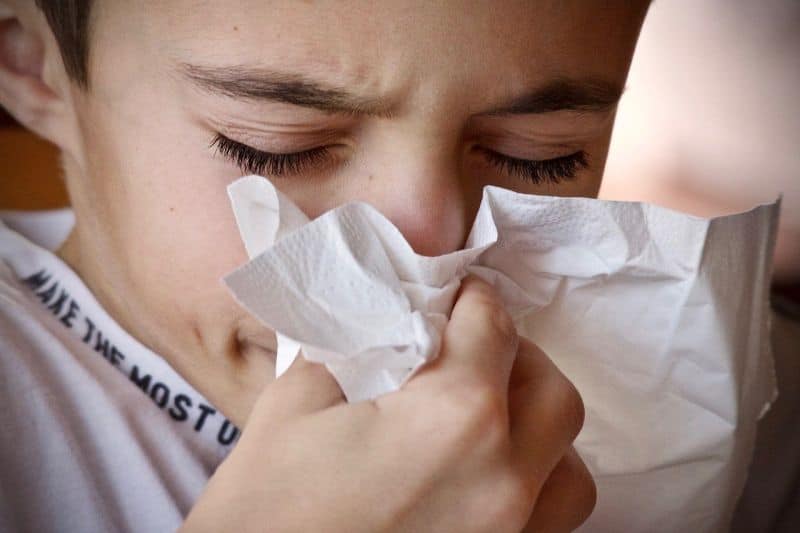
Air Purifiers for Pets: FAQs
Although the concept of an air purifier is pretty simple, the potential safety issues and technology involved cause many pet owners to have questions. We’ll try to help answer a few of the most common air purifier questions below!
Are air purifiers safe for pets?
Some are, but others aren’t. We recommend avoiding any that produce ozone or other harmful gases. The safest appear to be those that use mechanical filtration (HEPA filters) or activated carbon. UV filtration units also appear to be safe, as are purifiers that combine these three technologies.
Will air purifiers remove pet hair from the air?
Kinda. Many of the hairs your pet sheds will end up simply falling to the floor or clinging to your clothes (check out our guide to getting pet hair off clothing in the washer for tips on combating fur). Air purifiers can’t do anything about these, but good models will collect the hair blowing around in the air. Also, it bears mentioning that it is typically pet dander — rather than hair — which triggers allergies. And because dander is lighter than hair, it’ll usually float more readily and therefore be (eventually) filtered out by a purifier.
Will air purifiers eliminate pet odors?
Good ones will – particularly if they feature a carbon filter, as these filters bond with the odor-causing gases, changing their composition and eliminating the smell. HEPA filters may also help slightly, as they’ll remove some of the dander, saliva, and other foul-smelling particles your pet creates.
Do air purifiers help those with pet allergies?
Air purifiers with HEPA filters will likely help reduce allergy symptoms caused by pets, as they’ll remove the dander and other pet-produced particles from the air.
Can an air purifier help my pet’s allergies?
Perhaps – it depends on what your dog is allergic to. Air purifiers won’t do a thing about food allergies, for example, but they should help your dog feel better if she’s allergic to pollen, dust, smoke, or the dander of other animals living in your home, like cat allergies.
***
Now that you understand what to look for in an air purifier for your pet, which one do you intend to buy? Does one of the models we’ve recommended above seem like the perfect option for your home and family? Do you already have experience with one of the ones we’ve discussed?
Let us know your thoughts and tell us about your experiences in the comments below!


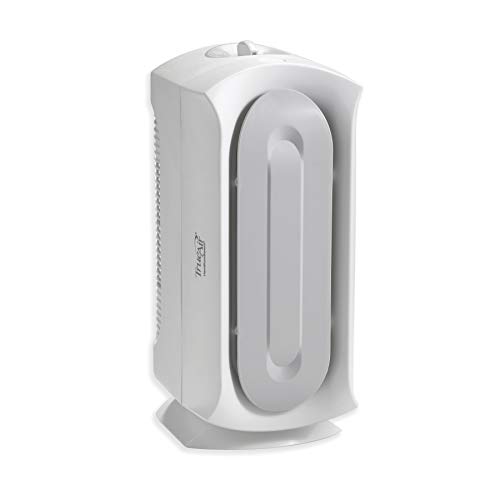



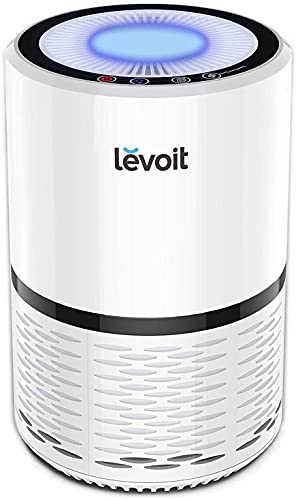





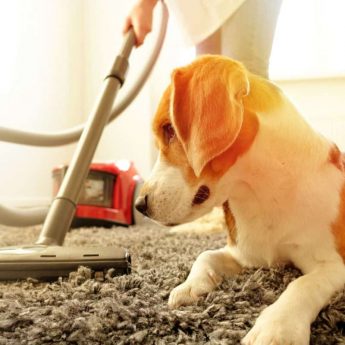
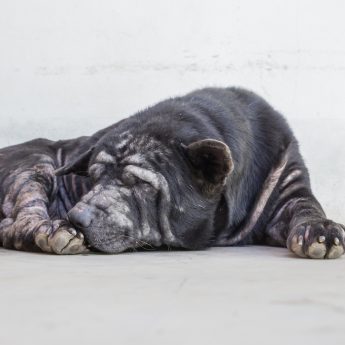
No Comments